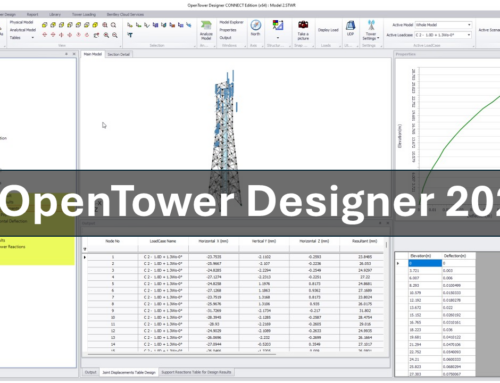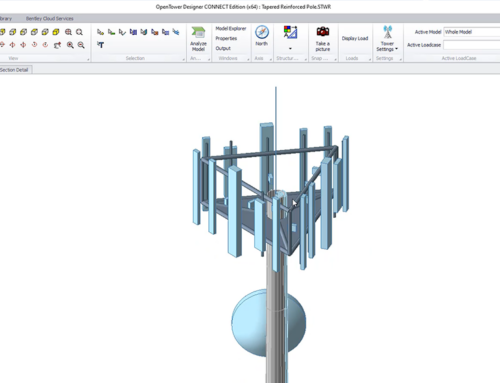OpenTower iQ data and reports get the engineering stamp of approval
A new study verified that the data generated by OpenTower iQ Digital Twins is accurate, certifying it for use in cell tower maintenance. The study, sponsored by Bentley, in partnership with a major U.S. carrier, used OpenTower iQ to mimic the post-construction audit process of recent tower installations by the carrier. The data generated by OpenTower iQ was compared with the best-available, pre-existing data of those towers to establish a measure of accuracy. The findings have confirmed that OpenTower iQ and software-generated reports are within engineering tolerances, confirming their effectiveness in the field. This verifies OpenTower iQ accuracy and usefulness in creating time and cost savings in cell tower maintenance.
Engineers confirmed that OpenTower iQ could faithfully analyze the Digital Twins it generates to create actionable engineering data and reports for cell tower owners and carriers with the levels of accuracy needed to perform most engineering and operational tasks. This solidifies OpenTower iQ as an integral part of the tower lifecycle and an excellent source for engineering and reporting data, streamlining the compliance process. With this validation, tower owners can use Digital Twins to carry out tower maintenance with confidence, greatly reducing the cost and time required.
Generating Accurate Digital Twins
Bentley’s OpenTower iQ software uses Artificial Intelligence (AI), Machine Learning (ML), and photogrammetry to generate accurate 3D models. These models serve as a Digital Twin, precisely representing the tower on the ground and serving as a single source of truth for all information about that tower. This helps engineering teams and other stakeholders plan at every part of the tower lifecycle. The study validates Digital Twins as an excellent way to plan changes and perform tower maintenance without needing more truck rolls to check the status of each individual tower. They’re especially useful for rollouts affecting numerous towers, such as the recent 5G upgrades, as they allow engineers to model the needed changes and see how they will affect the tower on the ground from their office.
Ensuring the Use of Digital Twins for the Field
The study was conducted with a high level of rigor and detail to ensure OpenTower iQ Digital Twins faithfully represent towers as they exist in reality. This faithful representation is what allows them to serve as a single source of truth for each tower, letting stakeholders make plans without worrying about the accuracy of their data. Engineers looked at several metrics to judge the accuracy of OpenTower iQ models: scaling, equipment inventory, as-built drawing, mount analysis, and approval capabilities with results such as:
- Cell Tower Height and Scaling Accuracy: OpenTower iQ accurately, within acceptable tolerances, calculates the height of a tower.
- Cell Tower Equipment Loading + Mount Analysis: OpenTower iQ was able to pinpoint, within acceptable tolerances, the RAD center’s height, the equipment positioning, and the space between equipment. It was also able to correctly measure tilt and azimuth.
- Cell Tower Drawings: Engineers agreed the drawings generated by OpenTower iQ are able to be used for the approval process.
These metrics have confirmed that OpenTower iQ’s Digital Twins can reliably replace many existing analog systems involved in the tower lifecycle, leading to time and cost savings.
Gain Confidence, Save Resources
The study results show substantial time and cost savings in tower maintenance for the telecommunications industry. Manual tower inspections that support traditional operations and maintenance typically cost about $5,700 per tower per year. OpenTower iQ reduces this burden by carrying out inspections with aerial or drone inspection. This drops operational and maintenance costs to an average of $2,200 per tower per year, for a proposed saving of $3,500 per tower per year. For tower owners and carriers servicing 500 towers, this translates to an annual cost savings of more than $1.7 million per year. For those servicing 10,000 towers, that scales to saving $35 million over the course of a year.
These savings amplify when you factor in the creation, analysis, and use of accurate data generated by OpenTower iQ. Over the course of a decade, OpenTower iQ delivers an estimated 15% annual reduction in total operational costs per cell tower and a 42% reduction in the cost of ownership per tower per year.
Tower owners and carriers can expect considerable cost savings as well. OpenTower iQ makes M&A transactions 33% faster and the entire leasing process 95% faster. The automation within the software also reduces the burden on tower engineers, freeing them to focus on the work they do best rather than time-consuming out-of-office visits. This applies to tower reporting processes as well: the study found OpenTower iQ can create an estimated 50%-time savings with its intelligent automation and reporting capabilities.
To learn more about the study, including details on study methodology and more ways OpenTower iQ can reduce the burden tower owners and carriers face throughout the tower life cycle, click the button below to download the whitepaper.




